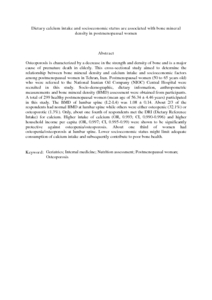Citation
Tajik, Esra and Mohd Shariff, Zalilah and Esfehani, Ali Jafarzadeh and Chan, Yoke Mun and Ebrahimi, Fatemeh
(2014)
Dietary calcium intake and socioeconomic status are associated with bone mineral density in postmenopausal women.
World Applied Sciences Journal, 31 (2).
pp. 244-252.
ISSN 1818-4952; ESSN: 1991-6426
Abstract
Osteoporosis is characterized by a decrease in the strength and density of bone and is a major cause of premature death in elderly. This cross-sectional study aimed to determine the relationship between bone mineral density and calcium intake and socioeconomic factors among postmenopausal women in Tehran, Iran. Postmenopausal women (50 to 65 years old) who were referred to the National Iranian Oil Company (NIOC) Central Hospital were recruited in this study. Socio-demographic, dietary information, anthropometric measurements and bone mineral density (BMD) assessment were obtained from participants. A total of 299 healthy postmenopausal women (mean age of 56.34 ± 4.46 years) participated in this study. The BMD of lumbar spine (L2-L4) was 1.08 ± 0.14. About 2/3 of the respondents had normal BMD at lumbar spine while others were either osteopenic (32.1%) or osteoporotic (1.3%). Only, about one fourth of respondents met the DRI (Dietary Reference Intake) for calcium. Higher intake of calcium (OR, 0.993; CI, 0.990-0.996) and higher household income per capita (OR, 0.997; CI, 0.995-0.99) were shown to be significantly protective against osteopenia/osteoporosis. About one third of women had osteopenia/osteoporosis at lumbar spine. Lower socioeconomic status might limit adequate consumption of calcium intake and subsequently contribute to poor bone health.
Download File
![[img]](http://psasir.upm.edu.my/37095/1.hassmallThumbnailVersion/Dietary%20calcium%20intake%20and%20socioeconomic%20status%20are%20associated%20with%20bone%20mineral%20density%20in%20postmenopausal%20women.pdf)  Preview |
|
PDF (Abstract)
Dietary calcium intake and socioeconomic status are associated with bone mineral density in postmenopausal women.pdf
Download (84kB)
| Preview
|
|
Additional Metadata
Actions (login required)
 |
View Item |

